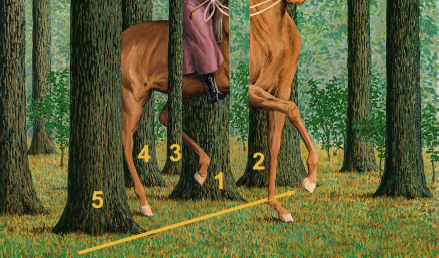
René Magritte (1898-1967), the great Belgian surrealist, once said ``...the function of art is to make poetry visible, to render thought visible''. The poetry emerged on his canvases by meticulous, aesthetically engaging depiction of objects and scenes replete with surprise and apparent perceptual self-contradiction. Visual neuroscience now recognizes that pictorial art can reveal some of the visual brain's ``neural rules'' and processing hierarchies. This article examines two salient exemplars drawn from Magritte's vast oeuvre. The first is his 1933 masterpiece, `La Condition Humaine' (The Human Condition), one of his most philosophical works. We see a room with a painting on an easel that appears to paradoxically reveal exactly what it occludes: a pastoral scene outside the room. I examine in detail the visual cues that elicit an alternation between salient yet mutually exclusive percepts, transparency vs opacity, of the same object. The conflicting percepts are experienced as surreal, drawing us into the heart of the problem: the nature of representation (in art and in the brain), and a meditation on the localization of thought, even the nature of reality. A second masterpiece, `Le Blanc Seing' (1965), is visually stunning, beautifully rendered and, at first glance, otherwise unremarkable. We see a tranquil scene with a woman on a horse passing through a stand of trees. However, Magritte has embedded several jarring effects that induce surreal competition between figure and background, challenging object integrity, including a shocking, apparent interruption of the horse's torso replaced with distant, background foliage. In the course of my research on Le Blanc-Seing, I came upon a plausible pictorial inspiration for the painting in a brief scene from a 1924 German silent film which I illustrate here. This connection had been hinted at before (Whitfield, 1992), but had never been demonstrated pictorially until now. Both of these masterpieces illustrate what I call the power of subtle painterly gesture, i.e. when small details act as `perceptual amplifiers', inducing a strong effect on both our perceptual and cognitive understanding of scene elements across a large region of visual space. In addition to their deep and complex aesthetic appeal, both works are also virtual courses in perception with many elements that direct our attention to the pictorial details that elicit perceptual figure-ground segregation, object identification, cues for depth perception, Gestalt Laws of occlusion-continuation and visual scene organization.